Quilt Repair Chronicle Week 4 Remembering Quilting Bees
/
Every day or two I pickup my quilt and add another line if stitching.
I was thinking about how often I’ve blogged about quilting from one perspective or another and wanted to remind you of a story I shared back in 2014. This is the story of an unplanned quilting bee. I’ve heard it many times through the years and I love the sense of community. I’d welcome such an event about now!
Golda Stepp laid out the layers of her quilt and carefully smoothed the fabric. As she tacked one end to the frame she wondered if she was starting this too early in the season. You put a quilt up to work on when the weather is cool. Summer months are filled with hoeing and canning. Anyway, it’s hot in the summer and who wants to sit under the layers of a quilt inside the house when it’s hot? Nonetheless Golda had a lovely quilt top that she was eager to finish and she had found a good quantity of unbleached domestic that made a fine backing so she would start this quilt today.
With the layers attached to one frame and the quilt rolled up as tightly as possible, she had just finished tacking the loose end to the remaining frame when she was called away by some inconsequential necessity of life, laundry or children or something like that.
She was just finishing the housework when she heard a light knocking and a familiar voice calling, “Goldie, you home?” Her husband’s aunt, Bessie Baldwin had stopped in for a quick visit.
Coming through the front door, the quilt frame caught Aunt Bessie’ eye hung in the front bedroom. “Oh, you’ve put up a quilt. Do you want me to run a line for ya?”
Quilts have many purposes and warmth while sleeping may be the least of these. The fellowship around a work-in-progress is priceless. So the two ladies took seats on opposite sides of the quilting frame and began their work. As needles flashed and straight lines of neat stitches inched their way behind them, Golda and Bessie caught up on the news of the family and the neighborhood. Hours can be lost in such work and the morning was gone before they realized it.
Whether it was the lowing of a cow, or the laughter of the children, something prompted Bessie to take her first look at the clock. “Well it’s half-past eleven. I’ve got to go fix Rufus some dinner. But I’ll be back as soon as he’s headed back to the field. We’ll get some more work done on this quilt before supper.”
Golda smiled, having enjoyed the visit and happy to see the progress on her pretty quilt. The Stepps would need their noon meal as well and so the quilt had to wait a couple of hours.
It was not later than one o’clock when the happy chatter of not just one faithful quilter but four could be heard coming down the lane. Bessie had met her younger sister, Gretchel Baldwin and enlisted her help for the afternoon. Gretchel brought along her own daughter and a visiting girlfriend.
Now there were five needles flashing, and three were very experienced quilters. A full quilting frame might see a whole quilt finished in a day. This quilt went from the very beginning stages to more than half finished before the visitors had to go home for the evening. And everyone was pleased with both the visit and the work accomplished.














